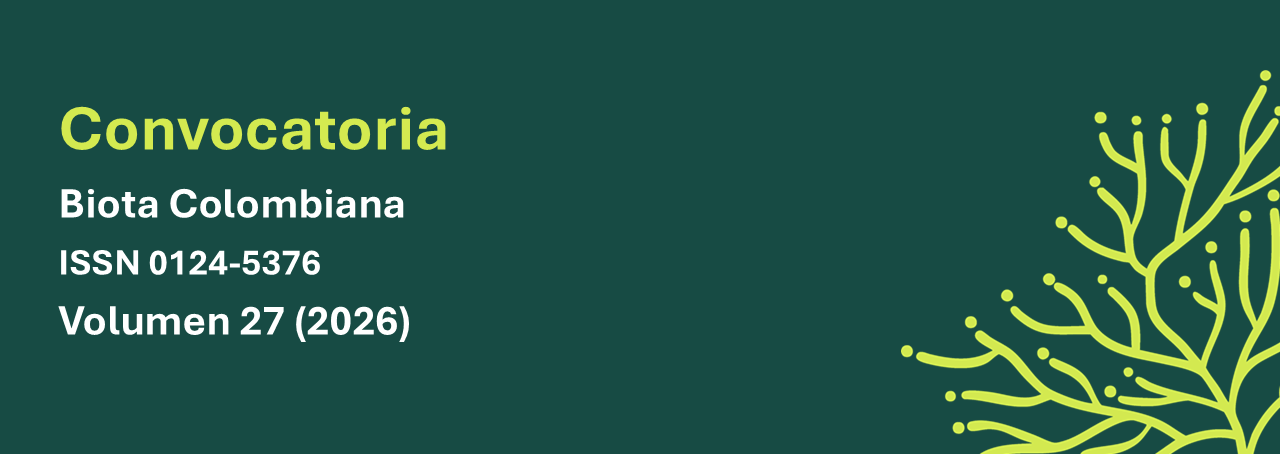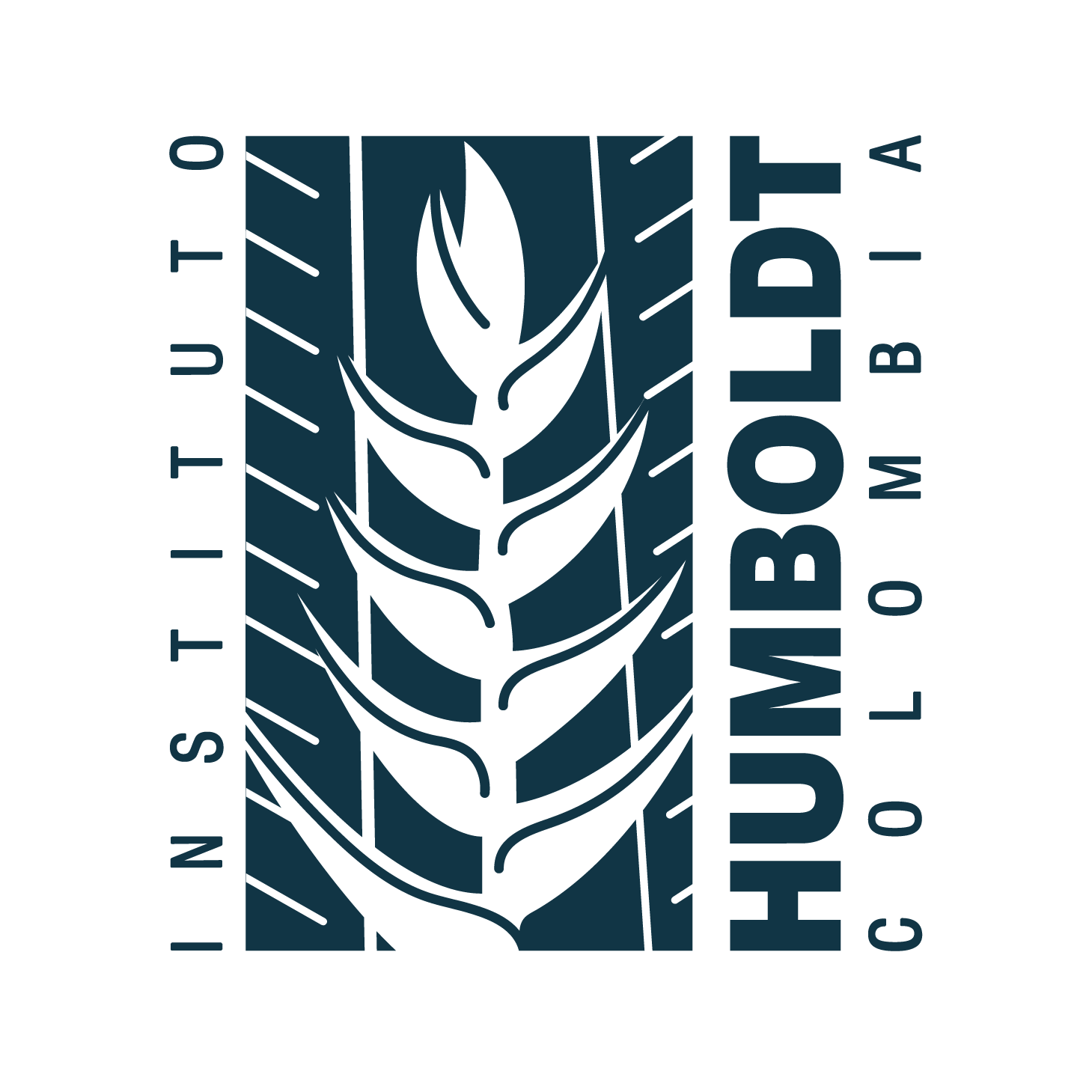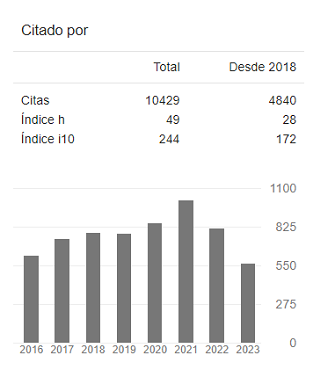Resumen (es):
Registramos Acanthagrion jessei, Nehalennia minuta y Perilestes solutus por primera vez en Colombia, con base en machos y hembras recolectados en el campus Barcelona de la Universidad de Los Llanos, ubicado en las estribaciones de los Andes Orientales colombianos en la cuenca del río Orinoco.
Resumen (en):
We record for the first time Acanthagrion jessei, Nehalennia minuta, and Perilestes solutus in Colombia, based on males and females taken at the campus Barcelona at the Universidad de Los Llanos, located in the foothills of the Colombian Eastern Andes in the Orinoco river basin.
Palabras clave:
Caballito del diablo, Coenagrionidae, Meta, Orinoquia, Perilestidae (es)
https://doi.org/10.21068/2539200X.1061
New species records in Acanthagrion, Nehalennia, and Perilestes (Odonata: Zygoptera) for Colombia
Nuevos registros de especies en Acanthagrion, Nehalennia y Perilestes (Odonata: Zygoptera) para Colombia
Karen Lineke Álvarez-Álvarez
 1*, Cornelio Andrés Bota-Sierra
1*, Cornelio Andrés Bota-Sierra
 2, 3, Jesús Manuel Vásquez-Ramos
2, 3, Jesús Manuel Vásquez-Ramos
 1
1
Recibido: 26 de febrero 2022
Aceptado: 4 de abril 2022
Citación: Álvarez-Álvarez, K. L., Bota-Sierra, C. A. & Vásquez-Ramos, J. M. (2022). New species records in Acanthagrion, Nehalennia, and Perilestes (Odonata: Zygoptera) for Colombia. Biota Colombiana, 23(2), e1061.
Abstract
We record for the first time Acanthagrion jessei, Nehalennia minuta, and Perilestes solutus in Colombia, based on males and females taken at the campus Barcelona at the Universidad de Los Llanos, located in the foothills of the Colombian Eastern Andes in the Orinoco river basin.
Key words. Coenagrionidae. Damselfly. Meta. Orinoquia. Perilestidae.
Resumen
Registramos Acanthagrion jessei, Nehalennia minuta y Perilestes solutus por primera vez en Colombia, con base en machos y hembras recolectados en el campus Barcelona de la Universidad de Los Llanos, ubicado en las estribaciones de los Andes Orientales colombianos en la cuenca del río Orinoco.
Palabras clave. Caballito del diablo. Coenagrionidae. Meta. Orinoquia. Perilestidae.
Introduction
Colombia is a megadiverse country, as its forests and freshwater ecosystems create ideal conditions for the establishment of various species of fauna and flora (Rangel, 2015). Within the fauna, insects correspond to 65.3% of the diversity of invertebrates recorded in the country (Escobar et al., 2020). The odonates in Colombia currently include more than 471 documented species (Álvarez-Álvarez et al. 2021, Stand-Pérez et al. 2021), and although they do not represent the highest diversity among insects, it is one of the most studied groups of insects (Bota-Sierra et al., 2016).
The genus Acanthagrion has a Neotropical distribution, from southeastern United States to central Argentina (Garrison et al., 2010), and comprises 42 species, 16 of which are known to occur in Colombia: Acanthagrion abunae, A. apicale, A. adustum, A. ascendens, A. floridense, A. fluviatile, A. inexpectum, A. kennedii, A. minutum, A. lancea, A. obsoletum, A. trilobatum, A. vidua, A. cuyabae, A. williamsoni, and A. yungarum (Pérez-Gutiérrez & Palacino-Rodríguez, 2011).
The genus Nehalennia groups six species with a wide distribution, one in Eurasia and the other five in the New World, from Canada to Brazil (Garrison et al., 2010), but there are no records from Colombia in the literature. The genus Perilestes has a South American distribution, occurring in the tropical rainforests of Colombia, Venezuela, Guyana, Surinam, Ecuador, Peru, Bolivia, and Brazil (Garrison et al., 2010). Eight species are recognized in the genus, one of them in Colombia, Perilestes kahli (Pérez-Gutiérrez & Palacino-Rodríguez, 2011).
Several sampling efforts have been carried out in the Colombian Orinoco basin (e. g., Bota-Sierra, 2014; Palacino-Rodríguez et al., 2017), and new records keep being reported from this rich area (Álvarez-Álvarez et al., 2021), showing that an intensive exploration of this region is needed to assess the real number of Odonata species inhabiting this place. Here we present three new records for the region and the country in the genera Acanthagrion, Nehalennia, and Perilestes.
Materials and methods
Study site and habitat. Sampling was done in January and December 2020 at the Colombian Eastern Andes foothills in the Meta department (4°04'20.8"N, 73°34'55.1"W, 380 m a.s.l.; Figure 1), on the Barcelona Campus (Universidad de los Llanos), where the natural vegetation corresponded to savanna ecosystem (Jaramillo-Justinico & Rangel-Ch., 2014). The climatic regime is unimodal, with a rainy season from April to November and a dry season from December to March (Minorta-Cely & Rangel-Ch., 2014). The maximum temperature reported is 32°C and the minimum is 20°C (IDEAM, 2019).
Map elaboration. A search for historic records of the species was carried out via Google Academic, using the following keywords: checklist, distribution, Odonata, Coenagrionidae, Perilestidae, Acanthagrion, Nehalennia, Perilestes, new records, A. jessei, N. minuta, and P. solutus. The resulting localities lacking geographic coordinates were approximated using Google Earth. Records from the Global Biodiversity Information Facility (GBIF, 2021) were included. The resulting map was generated by entering the records in the free access program Quantum GIS, version 3.18.2 (QGIS, 2021).

Figure 1. Geographic distribution of Acanthagrion jessei, Perilestes solutus and Nehalennia minuta, obtained from literature, GBIF records, and the new record for Colombia.
Specimen identifications. Specimens were deposited in the entomological collection at the Museo de Historia Natural Unillanos (MHNU-E). The specimens of A. jessei under the codes MHNU-E 2983, 3141,3193, 3228, 3268, 3269 and 3293; N. minuta with MHNU-E 3052 and 3056, and P. solutus with MHNU-E 3194 and 3230. Specimens were identified using an S9i Leica stereoscope and the taxonomic keys in Leonard (1977), Garrison et al. (2010), De Marmels (1984) and Williamson & Williamson (1924). Photographs were made using a Nikon D3300 camera, the software Adobe Photoshop 22.4.3 was used to align, stack and edit the photographs. Measurements were made using a digital caliper with a deviation of 0.05 mm for the abdomen (Ab), fore wing (FW), hind wing (HW) and total length (TL).
Results
The specimens of P. solutus were captured within a secondary forest composed of plants of the genera Poeppigia, Didymopanax, Zebrina, and Monstera, which are distributed around a drainage channel that crosses through the university campus. A. jessei was captured flying within secondary forest and around artificial ponds used for fish farming by the Instituto de Acuicultura de la Universidad de los Llanos (IALL). N. minuta was captured flying in an urban area, characterized by infrastructure such as classrooms, administrative buildings and laboratories, surrounded by vegetation predominated by Poeppigia, Erythrina, Bauhinia, Swietenia, Ceiba, and Ficus.
We collected seven adults of Acanthagrion jessei Leonard, 1977 (Figure 2a), two adults Nehalennia minuta (Selys in Sagra, 1857) (Figure 2b), and two adults of Perilestes solutus Williamson & Williamson, 1924 (Figure 3). All of them recorded for the first time for Colombia (Figure 1).

Figure 2. Adult Odonata collected at the Universidad de los Llanos, Meta, Colombia. A, Acanthagrion jessei couple; B, Nehalennia minuta female.

Figure 3. Adults of Perilestes solutus collected at the Universidad de los Llanos, Colombia. A, female; B, male.
All identified specimens agree with the descriptions and characteristics known for each of the species. The specimens of N. minuta match descriptions known for the species, according to De Marmels (1984), both males and females present frons sharply angulate (Figure 4a) and anterior portion of female mesepisterna with a pair of tubercles (Figure 4b). Measurements (mm) Ab, 21.90; FW, 12.77; HW, 12.20; TL, 26.78. Female (mm) Ab,23.12; FW,14.30; HW,14.67; TL, 29.03. P. solutus matches descriptions known for the species according to Williamson & Williamson (1924), including males with sternum 7-10 bright blue and females with segment 9 each side with a large lateral light brown spot (Figure 5). Measurements: males, Ab, 41.96; FW, 21.40; HW, 20.25; TL, 39.87 (mm). Females, Ab, 37.87; FW, 22.55; HW, 21.88; TL, 43.06 (mm). Specimens of A. jessei and A. temporale are usually very similar, Leonard (1977) mainly uses the ligula shape to separate these species (Figure 6a), but we also found that the shape of the cerci allows to differentiate them A. jessei has a dorsoapical bifurcated tubercle in the cercus, which can be observed in posterior view (Figure 6b); this same tubercle is present in A. temporale, but in this species it is not bifurcated. Also, in lateral view the external border of cercus of A. temporale is sinuous while in A. jessei it is straight (Figure 6c). Measurements of the four male specimens were (mm): Ab, 21.11; FW, 14.35; HW, 13.58; TL, 25.50. Measurements of the three female specimens were (mm): Ab, 24.07; FW, 18.42; HW, 17.12; TL, 28.72.

Figure 4. Morphological details of Nehalennia minuta female captured at Universidad de los Llanos, Meta, Colombia. A, frons sharply angulate; B, mesepisterna with a pair of tubercles.
Figure 5. Morphological details of Perilestes solutus captured at Universidad de los Llanos, Meta, Colombia. A, males with sternum 7-10 bright blue; B, male head in dorsal view; C, abdominal segments 7-10 of female in lateral view; D, female head in dorsal view.

Figure 6. Morphological details of Acanthagrion jessei captured at Universidad de los Llanos, Meta, Colombia. A, ligula in lateral view; B, cerci in dorsoapical view; C, cerci in lateral view.
Discussion
Habitat use recorded here for the three species coincides with those described for each of the genera. N. minuta was captured in the urban area of the university campus, 100 m from the drainage channel that crosses it and the ponds used for fish farming. Adults of the genus Nehalennia are known to inhabit grasslands around ponds or streams with slow moving water (Garrison et al. 2010). The adults of genus Perilestes are forest stream dwellers (Williamson & Williamson, 1924); P. solutus was found in the secondary forest, which together with the drainage channel, create the ideal conditions for the establishment of this specie. Finally, slow backwaters of streams and ponds are the most frequent habitats of the genus Acanthagrion (Garrison et al., 2010); A. jessei was found in both habitats generated by anthropic intervention within the university campus.
The three species have wide distributions, and all of them were previously recorded in countries neighboring with Colombia. A. jessei was previously recorded at Guyana, Peru and Brazil (Leonard, 1977; IUCN, 2020); P. solutus includes Brazil and Suriname (Bastos et al., 2019; Belle, 2002; Calvão et al., 2014; Garcia-Júnior & Picanco-Souto, 2021; Machado, 2015); and N. minuta has a broader distribution including Cuba, Suriname, Costa Rica, Mexico, Dominican Republic, Guyana, United States of America, Guatemala, Jamaica, Trinidad and Tobago (De Marmels, 1984; Belle, 2002; Ramírez et al., 2000; Paulson & Dunkle, 2021; GBIF, 2021). The new reports of these species for Colombia highlight the importance of studying the odonatofauna, as much remains to be discovered.
Acknowledgements
We thank the Museo de Historia Natural Unillanos (MHNU), for the loan of the facilities and equipment necessary for identification; the Biology Laboratory of the Universidad de Los Llanos, for the loan of the S9i Leica stereoscopic microscope equipment for taking photographs; Miguel Ángel Cortés and Jorge Enrique García Melo, for their help in photo editing, and the reviewers for their comments that improved the manuscript. This is publication number 13 of the MHNU.
References
Álvarez-Álvarez, K. L., Bota-Sierra, C. A. & Vásquez-Ramos, J. M. (2021). New records of genera Aphylla and Micrathyria for Colombia (Odonata: Gomphidae, Libellulidae). Notulae Odonatologicae, 9(8), 358-366.
https://doi.org/10.5281/zenodo.5702959
Bastos, R. C., Brasil, L. S., Carvalho, F. G., Calvão, L. B., Silva, J. O. & Juen L. (2019). Odonata of the state of Maranhão, Brazil: Wallacean shortfall and priority areas for faunistic inventories. Biota Neotropica, 19.
https://doi.org/10.1590/1676-0611-BN-2019-0734
Belle, J. (2002). Commented checklist of the Odonata of Surinam. Odonatologica, 31(1), 1-8.
Bota-Sierra, C. A. (2014). Nine new records of Odonata for Colombia from the Orinoco Basin (Lestidae, Calopterygidae, Heteragrionidae, Coenagrionidae, Libellulidae). Notulae Odonatologicae, 8(4), 77-116.
Bota-Sierra, C.A., Maufray, B., Palacino-Rodríguez, F., Hofmann, J., Tennessen, K., Rache, L. & Tognelli, M. F. (2016). Estado de conservación de las libélulas de los Andes Tropicales. En: Tognelli M. F., Lasso C. A., Bota-Sierra, C. A., Jiménez-Segura, L.F., Cox, N. A. (Ed.). Estado de Conservación y Distribución de la Biodiversidad de Agua Dulce en los Andes Tropicales. UICN Gland, Suiza, Cambridge & Arlington.
Calvão, L. B., Júnior, P. D. & Batista, J. D. (2014). Odonata (Insecta) from Nova Xavantina, Mato Grosso, Central Brazil: Information on species distribution and new records. Check List, 10(2), 299-307,
https://doi.org/10.15560/10.2.299
De Marmels, J. (1984). The genus Nehalennia Selys, its species and their phylogenetic relationships (Zygoptera: Coenagrionidae). Odonatologica, 13(4), 501-527.
Escobar, D., Plata, C. & Ortiz, R. (2020). SiB Colombia Inventario nacional de la biodiversidad desde los datos abiertos. En: Moreno, L. A., Andrade, G. I., Didier, G & Hernández-Manrique, O. L. (Ed.). Biodiversidad 2020. Estado y tendencias de la biodiversidad continental de Colombia. Instituto de Investigación de Recursos Biológicos Alexander von Humboldt. Bogotá, D. C., Colombia.
Garcia-Júnior, M. D. & Picanço-Souto, R .N. (2021). Primeiro registro de Perilestidae (Odonata: Zygoptera) para o estado do Amapá, Brasil. Biota Amazônia (Biote Amazonie, Biota Amazonia, Amazonian Biota), 11(1), 85-86.
https://doi.org/10.18561/2179-5746/biotaamazonia.v11n1p85-86
GBIF-Global Biodiversity Information Facility (2021). Online on the internet, URL (20-X-2021).
https://doi.org/10.15468/dl.d995bd
IDEAM-Instituto de Hidrología, Meteorología y Estudios Ambientales (2019). Atlas climatológico de Colombia. IDEAM.
IUCN-International Union for Conservation of Nature (2020). The IUCN Red List of Threatened Species. Version 2020-2.
www.iucnredlist.org.
Jaramillo-Justinico, A. & Rangel-Ch., J. O. (2014). Las unidades del paisaje y los bloques del territorio de la Orinoquia. En: Rangel-Ch. J. O. (Ed.). Colombia Diversidad Biótica XIV: La región de la Orinoquia de Colombia. (Pp: 101-152). Universidad Nacional de Colombia.
Machado, A. (2015). Perilestes eustaquioi sp. nov. and new distributional records of Perilestidae (Odonata) in Brazil. Zoologia (Curitiba), 32, 428-430.
https://doi.org/10.1590/S1984-46702015000500012
Paulson, D. R. & Dunkle, S. W. (2021). A Checklist of North American Odonata. Occasional Paper No. 56 (1999), Slater Museum of Natural History, University of Puget Sound; updated in 2021. Downloadable from the Odonata Central website.
Pérez-Gutiérrez, L. & Palacino-Rodríguez, F. (2011). Updated checklist of the Odonata known from Colombia. Odonatologica, 40(3), 203-225.
QGIS Equipo de Desarrollo. (2021). Sistema de información geográfica de código abierto. Proyecto de Fundación Geoespacial. Versión 3.18.2. Online on the Internet, URL (15-iv-2021):
https://qgis.org/es/site/
Ramírez, A., Paulson, D. R. & Esquivel, C. (2000). Odonata of Costa Rica: Diversity and checklist of species. Revista de Biología Tropical, 48(1), 247-254.
Stand-Pérez, M. Á., Montes-Fontalvo, J. & Pérez-Gutiérrez, L. A. (2021). Sixteen new records of Odonata for Colombia from the Araracuara Region (Perilestidae, Calopterygidae, Heteragrionidae, Megapodagrionidae, Polythoridae, Coenagrionidae, Aeshnidae, Gomphidae, Libellulidae). Notulae Odonatologicae, 9(8), 378-388.
1Universidad de los Llanos. Villavicencio, Colombia.
2Alabama Museum of Natural History, The University of Alabama. Tuscaloosa, Estados Unidos.
3Universidad de Antioquia. Medellín, Colombia.
*Autor de correspondencia
Referencias
Álvarez-Álvarez, K. L., Bota-Sierra, C. A. & Vásquez-Ramos, J. M. (2021). New records of genera Aphylla and Micrathyria for Colombia (Odonata: Gomphidae, Libellulidae). Notulae Odonatologicae, 9(8), 358-366. https://doi.org/10.5281/zenodo.5702959
Bastos, R. C., Brasil, L. S., Carvalho, F. G., Calvão, L. B., Silva, J. O. & Juen L. (2019). Odonata of the state of Maranhão, Brazil: Wallacean shortfall and priority areas for faunistic inventories. Biota Neotropica, 19. https://doi.org/10.1590/1676-0611-BN-2019-0734
Belle, J. (2002). Commented checklist of the Odonata of Surinam. Odonatologica, 31(1), 1-8.
Bota-Sierra, C. A. (2014). Nine new records of Odonata for Colombia from the Orinoco Basin (Lestidae, Calopterygidae, Heteragrionidae, Coenagrionidae, Libellulidae). Notulae Odonatologicae, 8(4), 77-116.
Bota-Sierra, C.A., Maufray, B., Palacino-Rodríguez, F., Hofmann, J., Tennessen, K., Rache, L. & Tognelli, M. F. (2016). Estado de conservación de las libélulas de los Andes Tropicales. En: Tognelli M. F., Lasso C. A., Bota-Sierra, C. A., Jiménez-Segura, L.F., Cox, N. A. (Ed.). Estado de Conservación y Distribución de la Biodiversidad de Agua Dulce en los Andes Tropicales. UICN Gland, Suiza, Cambridge & Arlington.
Calvão, L. B., Júnior, P. D. & Batista, J. D. (2014). Odonata (Insecta) from Nova Xavantina, Mato Grosso, Central Brazil: Information on species distribution and new records. Check List, 10(2), 299-307, https://doi.org/10.15560/10.2.299
De Marmels, J. (1984). The genus Nehalennia Selys, its species and their phylogenetic relationships (Zygoptera: Coenagrionidae). Odonatologica, 13(4), 501-527.
Escobar, D., Plata, C. & Ortiz, R. (2020). SiB Colombia Inventario nacional de la biodiversidad desde los datos abiertos. En: Moreno, L. A., Andrade, G. I., Didier, G & Hernández-Manrique, O. L. (Ed.). Biodiversidad 2020. Estado y tendencias de la biodiversidad continental de Colombia. Instituto de Investigación de Recursos Biológicos Alexander von Humboldt. Bogotá, D. C., Colombia.
Garcia-Júnior, M. D. & Picanço-Souto, R .N. (2021). Primeiro registro de Perilestidae (Odonata: Zygoptera) para o estado do Amapá, Brasil. Biota Amazônia (Biote Amazonie, Biota Amazonia, Amazonian Biota), 11(1), 85-86. https://doi.org/10.18561/2179-5746/biotaamazonia.v11n1p85-86
Garrison, R. W., Von Ellenrieder, N. & Louton, J. A. (2010). Dragonfly genera of the New World: illustrated and annotated key to the Zygoptera. JHU Press.
GBIF-Global Biodiversity Information Facility (2021). Online on the internet, URL (20-X-2021). https://doi.org/10.15468/dl.d995bd
IDEAM-Instituto de Hidrología, Meteorología y Estudios Ambientales (2019). Atlas climatológico de Colombia. IDEAM.
IUCN-International Union for Conservation of Nature (2020). The IUCN Red List of Threatened Species. Version 2020-2. www.iucnredlist.org.
Jaramillo-Justinico, A. & Rangel-Ch., J. O. (2014). Las unidades del paisaje y los bloques del territorio de la Orinoquia. En: Rangel-Ch. J. O. (Ed.). Colombia Diversidad Biótica XIV: La región de la Orinoquia de Colombia. (Pp: 101-152). Universidad Nacional de Colombia.
Leonard, J. W. (1977). A revisionary study of the genus Acanthagrion (Odonata: Zygoptera). Miscellaneous publications, Museum of Zoology, University of Michigan, 153, 1-173.
Machado, A. (2015). Perilestes eustaquioi sp. nov. and new distributional records of Perilestidae (Odonata) in Brazil. Zoologia (Curitiba), 32, 428-430. https://doi.org/10.1590/S1984-46702015000500012
Minorta-Cely, V. & Rangel-Ch., J. O. (2014). El clima de la Orinoquia colombiana. En: Rangel-Ch. J. O. (Ed.). Colombia Diversidad Biótica XIV: La región de la Orinoquia de Colombia. (Pp. 207-236), Universidad Nacional de Colombia.
Paulson, D. R. & Dunkle, S. W. (2021). A Checklist of North American Odonata. Occasional Paper No. 56 (1999), Slater Museum of Natural History, University of Puget Sound; updated in 2021. Downloadable from the Odonata Central website.
Palacino-Rodríguez, F., Bota-Sierra, C. A., Amaya, C. & Contreras, N. (2017). Libélulas y caballitos del diablo del departamento del Meta, Colombia. Editorial Universidad El Bosque, Bogotá.
Pérez-Gutiérrez, L. & Palacino-Rodríguez, F. (2011). Updated checklist of the Odonata known from Colombia. Odonatologica, 40(3), 203-225.
QGIS Equipo de Desarrollo. (2021). Sistema de información geográfica de código abierto. Proyecto de Fundación Geoespacial. Versión 3.18.2. Online on the Internet, URL (15-iv-2021): https://qgis.org/es/site/
Rangel, J. O. (2015). La biodiversidad de Colombia: significado y distribución regional. Revista de la Academia Colombiana de Ciencias Exactas, Físicas y Naturales, 39(151), 176-200.
Ramírez, A., Paulson, D. R. & Esquivel, C. (2000). Odonata of Costa Rica: Diversity and checklist of species. Revista de Biología Tropical, 48(1), 247-254.
Stand-Pérez, M. Á., Montes-Fontalvo, J. & Pérez-Gutiérrez, L. A. (2021). Sixteen new records of Odonata for Colombia from the Araracuara Region (Perilestidae, Calopterygidae, Heteragrionidae, Megapodagrionidae, Polythoridae, Coenagrionidae, Aeshnidae, Gomphidae, Libellulidae). Notulae Odonatologicae, 9(8), 378-388.
Williamson, E. B. & Williamson, J. H. (1924). The genus Perilestes (Odonata) Miscellaneous Publications, Museum of Zoology, University of Michigan, 14, 1-39.
Cómo citar

Esta obra está bajo una licencia internacional Creative Commons Atribución-NoComercial-SinDerivadas 4.0.
Derechos de autor 2022 Instituto de Investigación de Recursos Biológicos Alexander Von Humboldt




















